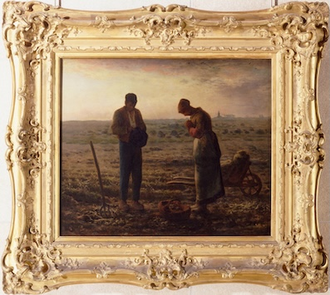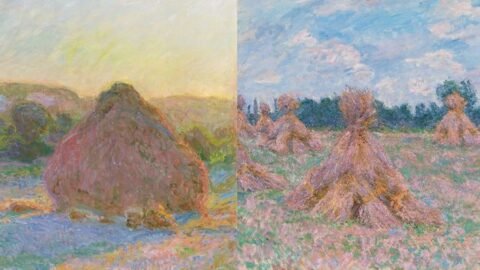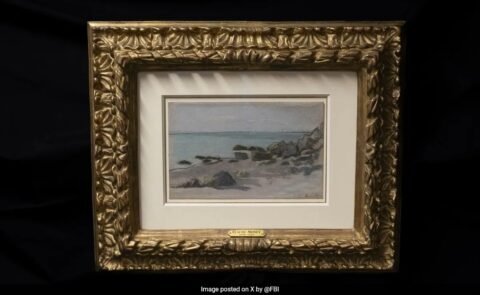
L’Angélus, Musée d’Orsay, Paris © Musée d’Orsay, Dist Grand Palais Rmn/Patrice Schmidt
Marking the 150th. anniversary of Jean-François Millet’s death the National Gallery has dedicated this free exhibition to the French Realist artist most famous for his painting ‘The Angelus’.
His rural scenes of peasant life in nineteenth century France were particularly popular in Victorian Britain. When he died in 1875 his pictures were being avidly collected, especially in Scotland, resulting in a considerable number being donated to British public museums.
Nine atmospheric paintings and six drawings are displayed in Room I.
National Gallery curator Sarah Herring and Simon Kelly from St.Louis Art Museum, Missouri have written a concise and comprehensive publication to accompany the exhibition. They cast further light on this enigmatic nineteenth century artist, concentrating on his work from 1840 as the leading artistic exponent of French rural life.
Born in 1814 in Gruchy, Normandy, to a devout prosperous farming family he exhibited artistic talent from an early age, especially drawing from memory. He was encouraged to study art with a portrait painter from Cherbourg who had been a pupil of celebrated artist David.
Given a stipend he enrolled in the Ecole des Beaux Arts in Paris at the studio of Delaroche.
He submitted his painting of ‘St.Anne Teaching the Virgin’ to the Salon in 1839, which was declined, but a portrait the following year was accepted. He met Paul Durand Ruel, the art dealer, who purchased several of Millet’s works.
Millet began painting peasants and their occupations in the late 1840’s, a time of turbulence in France and Europe.1848 was known as the Year of Revolutions.
In 1849 he moved to Barbizon in the Fontainbleu Forest becoming associated with the Barbizon School of artists, renowned for landscapes, although Millet was unique in his distinct portrayal of peasants labour.
He submitted ‘The Sower’, now in Cardiff’s National Museum collection at the 1850 Salon to considerable acclaim. He made several versions and Van Gogh was particularly influenced by the picture .
Subsequent work was regarded with suspicion as having political overtones by conservatives. He depicted peasants with dignity and the nobility of work, although republicans and liberals felt he did not seek to overthrow the status quo but ennoble it. Millet claimed to be influenced solely by Biblical allusions .
Although not a regular churchgoer, Millet’s Catholic faith and Marian devotion influenced his life and art. After his first wife’s death he married his second wife in a civil ceremony and only had it regularised by a priest a few weeks before his death.
He produced several religious pictures of the Virgin Mary. A life sized picture of Notre Dame de Lorrette was installed as a shop sign in Paris’ ninth arondissement in 1851. Some of his paintings alluded to Marian imagery in contemporary rural scenes.
In1858, four years after the Papal promulgation of the Doctrine of the Immaculate Conception, Pope Pius IX commissioned Millet to produce a painting for his chapel on the Papal train. He produced the painting in two months. Illustrated in the catalogue Mary, crowned with stars, is depicted standing on a crescent moon crushing a serpent, symbolic of Satan, beneath her foot as the Woman of the Apocalypse in the Book of Revelation. To the modern eye it is a fairly conventional image but the Pope considered the Realist features inappropriate and declined the picture, complaining that the French could not paint Madonnas.
At the same time Millet was working on the iconic ‘Angelus’, 1859, inspired by remembrance of his grandmother making workers and himself pause to remembering the Creator and creation by praying the words of the angel Gabriel in the Hail Mary.
A couple harvesting their potato crop stop to devoutly pray as the evening Angelus church bell tolls in the distance. The church is where Millet was buried .
Millet focused especially on women’s solitary work in the home and farmyard with shepherdesses, goose girls and milkmaids strongly represented in the exhibition.
The ‘Faggott Gatherers’, 1850-5 has a contemplative, mystical air with a barefoot serene young woman, leaning on her staff. She gazes at an older women seated on her bundle of sticks whose knarled hands indicate her labour.
There is a connection between the two as their eyes meet, echoing perhaps Mary with her mother St.Anne. It is more uplifting than the other ‘Faggott Gatherers’, 1868, depicting three exhausted women bowed down by the weight of their load, whilst portraying a kind of noble symmetry.
Men’s toil is energetically portrayed in ‘The Wood Sawyers’, an impressive depiction in oil,1850-2. The chalk and watercolour ‘Wood Choppers’ convey their human effort in every sinew as does the drawing of ‘Two Men sawing and splitting wood’.
Sculptural faces and features in light and shade are not defined, but distinctly representative of hardworking peasantry, giving them a heroic stance.
During his last ten years Millet achieved recognition and was awarded the Legion d’ Honoure in 1865.
A British obituary claimed Millet’s art was ‘to the Englishman suggestive of the poetry and sentiment of Burns and the sympathetic feeling for nature of Wordsworth.’
His influence on modern art was considerable and echoed in The Glasgow Boys, Impressionists and Salvador Dali.
Visit: www.nationalgallery.org for more details.





